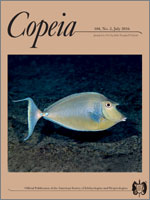The Sabine Map Turtle (Graptemys sabinensis) inhabits the Sabine-Neches, Calcasieu, and Mermentau river drainages of southwestern Louisiana and east Texas. Sparse data in the literature mark it as having among the smallest body sizes and smallest clutch sizes among the 14 species of the genus Graptemys. All available data on life history originate from the upper Sabine and upper Calcasieu drainages, which are relatively high-gradient rivers with fast currents and numerous sandbars. Downstream segments of these drainages and the entire Mermentau drainage have almost no gradient, with little perceptible current and no sandbars. We sampled G. sabinensis from the Mermentau River and upper and lower portions of both the Sabine and Calcasieu drainages. We collected data on body size and radiographed gravid females in the lower Calcasieu and Mermentau drainages to examine clutch size and egg width and compared our data to literature records and measurements of museum specimens. Both males (to 104 mm in midline plastron length) and females (to 202 mm) were considerably larger in the Mermentau and lower reaches of the Sabine and Calcasieu drainages than in the upper Sabine and upper Calcasieu drainages (to 92 mm and 176 mm, respectively). Clutch sizes were also significantly larger in the Mermentau and lower Calcasieu (mean 5.3 eggs, range 3–7) compared to previously reported clutch sizes for the upper Sabine and upper Calcasieu drainages (mean 2.3 eggs, range 1–4). Comparison with recent findings for other species of Graptemys indicates that it is typical for populations in faster-current habitats to be smaller in body size, although no previous report has shown the magnitude of differences exhibited by G. sabinensis in the present study. Examination of the allometry of reproductive output complemented previous studies of Graptemys in that both egg width and clutch size were hypoallometrically related to female body size, consistent with the hypothesis of anatomical constraints on egg width. The difference between egg width and pelvic aperture width grew larger as females increased in size, suggesting that anatomical constraints may have applied only to smaller females, leaving egg-size optimization possible in larger females. We could not determine the reason for a significant difference in egg width between the Mermentau and lower Calcasieu after correction for female body size, as pelvic aperture width did not vary between the drainages; however, other potential anatomical constraints on egg width were not measured.
How to translate text using browser tools
9 June 2016
Habitat-Related Variation in Body Size and Reproductive Output and an Examination of Reproductive Allometry in the Sabine Map Turtle (Graptemys sabinensis) across Three River Drainages
Amy K. Fehrenbach,
Irvin Louque,
Stacy L. McFadden,
Cybil Huntzinger,
Eddie Lyons,
Stephen H. Shively,
Will Selman,
Peter V. Lindeman
ACCESS THE FULL ARTICLE





